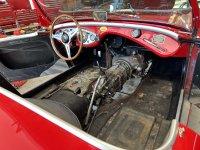Offline
I have a Toyota transmission with a BJ clutch in my 100. Lately I have noticed that unless I depress the clutch pedal all the way to the floor the clutch will not fully disengage and with the transmission in first gear the car will v-e-r-y slowly creep ahead.
Hydraulics seem to be in order and the pedal feels okay though I have not yet bled the system. I have read that sometimes this condition is due to wear in the clutch linkage with some of the holes egging out, thus causing less activation of the clutch rod.
Before I tear apart the interior to pull the tunnel I thought I would tap into the forum's wisdom--Any thoughts and suggestions will be appreciated.
Hydraulics seem to be in order and the pedal feels okay though I have not yet bled the system. I have read that sometimes this condition is due to wear in the clutch linkage with some of the holes egging out, thus causing less activation of the clutch rod.
Before I tear apart the interior to pull the tunnel I thought I would tap into the forum's wisdom--Any thoughts and suggestions will be appreciated.

 Hi Guest!
Hi Guest!

 smilie in place of the real @
smilie in place of the real @
 Pretty Please - add it to our Events forum(s) and add to the calendar! >>
Pretty Please - add it to our Events forum(s) and add to the calendar! >> 



